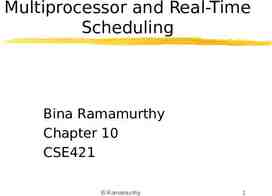Understaffed? Learn how to optimize your most valuable
15 Slides1.15 MB
Understaffed? Learn how to optimize your most valuable resource through effective scheduling. Presented by Minh Dang 211 LA County [email protected]
Objectives What is Workforce Management? Workforce Management Process Map. Workforce Management Challenges. Workforce Management Stakeholders. 2
What is Workforce Management? Workforce management provides proactive planning and real time implementation related to forecasting and scheduling of contact center resources. This planning includes long term strategic direction as well as flawless tactical execution and real time control plans. Our mission is to provide consistent positive results for inquirers, community resource advisors, and the community we serve as a whole. The goal of workforce management is to have the precise number of staff needed every single half hour of the day – not too many and not too few, making sure enough staff are available on the phones to respond to inquirers with a minimum of delay (as defined by an applicable service level agreement). The majority of costs associated with a call center are attributable to personnel. It is imperative to get the just right number of staff in place. Workforce management is both an art and science of getting the “just right” number of staff in place every period of the day to meet service levels while minimizing cost. It’s an art because the process is, after all, predicting the future. And the accuracy of any staffing plan will be due in part to judgment and experience. But it’s also a science – a step-by-step mathematical process that takes past history and uses it to predict future events. 3
Workforce Management Process Map Demand Driver Forecast Create Strategic Forecast & Plan Infrastructure & Capacity Validation Scheduling Review Staff Plan Recruit & Hire Capacity Planning Conduct Training & Nesting Create Tactical Forecast & Plan Real-time Management and Service Level Monitoring 4
Workforce Management Process Map Create Create Strategic Strategic Forecast Forecast & & Plan. Plan. Collect Collect input input data data for for baseline baseline forecast. forecast. Gather Gather and and validate validate historical historical data. data. The The first first step step of of the the process process is is gathering gathering aa representative representative sample sample of of historical historical information information that that can can be be analyzed analyzed to to predict predict future future volumes volumes and and patterns. patterns. This This data data represents represents the the volume volume of of calls calls offered offered and and handle handle time time information information from from aa representative representative period period of of time. time. The The minimum minimum recommendation recommendation is is at at least least 13 13 weeks weeks of of data. data. Forecast Forecast accuracy accuracy will will be be dependent dependent upon upon the the number number of of weeks weeks of of data data collected. collected. The The data data is is reviewed reviewed carefully carefully to to ensure ensure no no data data aberrations aberrations exist exist and and that that non-representative non-representative data data is is normalized normalized or or discarded discarded before before the the forecasting forecasting analysis analysis begins. begins. Review Review forecast forecast input input data. data. Create Create base base strategic strategic forecast. forecast. Review Review and and decision decision initiatives initiatives impacting impacting baseline baseline forecast. forecast. Determine Determine impact impact of of drivers. drivers. In In addition addition to to analyzing analyzing historical historical information, information, knowledge knowledge of of other other drivers drivers that that may may affect future workload is necessary. Many different factors affect the volume, pattern, and length of contacts affect future workload is necessary. Many different factors affect the volume, pattern, and length of contacts coming coming into into the the agency. agency. Initial Initial run run and and review. review. Forecast Forecast workload. workload. Workforce Workforce planning planning involves involves the the application application of of forecasting forecasting models models to to the the historical historical information information in in order to predict future workload. This includes identifying trends and seasonal patterns to forecast order to predict future workload. This includes identifying trends and seasonal patterns to forecast future future call call volumes, volumes, which which are are then then extrapolated extrapolated into into daily daily and and half-hourly half-hourly volumes volumes and and patterns. patterns. Build Build classes classes to to balance balance staffing staffing needs. needs. Review Review with with operator operator and and key key partners. partners. Finish Finish staff staff plan plan package. package. Calculate Calculate workforce workforce requirements. requirements. Create Create aa staffing staffing plan plan to to calculate calculate the the number number of of staff staff required required to to handle handle aa given given amount of work in a desired service timeframe. Various tradeoffs are evaluated to determine the impact amount of work in a desired service timeframe. Various tradeoffs are evaluated to determine the impact of of staffing staffing levels levels on on service, service, productivity productivity levels, levels, and and costs. costs. Review. Review. 5
Workforce Management Process Map Infrastructure & Capacity Validation. Check physical capacity. Perform an audit of workspace, staff count, hotel ratio, training space, and parking area. Check technology capability. Work with technology partners to make decisions and recommendations. Check people & process capacity. Work to ensure there is sufficient training space and trainers. Audit/test workspace. Test connectivity to all necessary applications. Validate each workspace is appropriately configured, i.e. has a phone, headset, chair, workstation, training materials, reference materials, etc. Verify applicable security access and seating charts. 6
Workforce Management Process Map Review Staff Plan. Reallocate staffing by adjusting skill profiles or schedules. Turnaround time will be constrained by internal policies and training requirements. Adjust hiring plan. Allow for sufficient recruiting and training time. Add or reduce classes or number of new hires as business needs dictate. Recruit & Hire. Conduct Training & Nesting. Staff plan should reflect an increase in handle time and decrease in productivity during the mentoring period. 7
Workforce Management Process Map Create Tactical Forecast & Plan. Collect historical data for baseline forecast. Collect historical initiative data. Review forecast performance for most recent period. Determine model and create forecast. Overlay baseline with initiative forecast. Complete final tactical forecast. Create a set of schedules that best match the workforce to the expected contact workload. Base staff requirements are calculated and then matched up to an organization’s potential staffing pool and the scheduling rules and constraints to design a schedule plan. Review with management staff. 8
Real-time Management and Service Level Monitoring Balancing the work requirements and resources to achieve a desired quality of service is the essence of Workforce Management. The responsibility does not end with the production of optimal schedules. All planned off-phone activities such as coaching, team meetings, vacations, and training are then added to the schedules. Last-minute initiatives are taken into account and planned. All activities are coordinated to maintain operational stability. Changes in employee status, such as illness or tardiness, or unforeseen changes in the workload dictate that conditions be constantly monitored and timely adjustments made. 9
Real-time Management and Service Level Monitoring Service level monitoring is essential in a dynamic environment. It dictates what adjustments should be made, and our ability to accommodate any requested changes to the plan. 10
Workforce Management Challenges Costs of overstaffing. Lower overall productivity and occupancy. Excess dollars spent for unnecessary staffing. Boredom and attrition (if there are extended periods of time with insufficient work to do). Unrealistic inquirer expectations of service. Overstaffing results in minimal wait times for inbound volume from inquirers. While this may sound like an ideal situation, it can be problematic. The lack of a queue during overstaffed periods may contribute to escalated expectations of service that are difficult to achieve consistently. 11
Workforce Management Challenges Costs of understaffing. Poor service to callers. When there is not enough available staff to handle the workload, inquirers are kept waiting in queue for longer periods of time, which triggers growing dissatisfaction. Customer satisfaction might not be affected upon initial entry into the queue (as most customers tend to expect a short wait). But as the time in the queue lengthens and customers receive no status information about when they might be served, frustration levels rise and satisfaction with the queue experience drops dramatically. This is because of the unique nature of the call center queue (also known as the invisible queue), where the caller usually has no information upon which to base a decision about whether to accept the queue and wait in line, try back at another time, or simply go away. Lost opportunity with every caller disconnect. Lower staff morale and motivation. With too few people to take calls, the available staff are forced to take call after call with no break in-between. Advisors will become frustrated and quality may suffer as a result. Rising attrition and turnover costs. Some may burn out and leave the job entirely, resulting in turnover and training costs. 12
Workforce Management Challenges The most significant factor that sets call centers apart is the pattern in which the work arrives. Monthly, weekly, and hourly patterns can generally be determined by analyzing historical call volumes and other business factors. Therefore, a call center may have a reasonable prediction of the number of calls it expects to receive in an hour or half-hour period. What cannot be predicted, however, is how many of those calls will arrive in the first minute, the second, the fifteenth, and so on. In other words, the pattern of calls within the hour or half-hour is random. This random arrival of work has a significant effect on how call workload is predicted and how staffing resources are determined. An implication of this random workload is that there is often an imbalance of work and staff to handle that work. Either there are too few calls arriving and staff are sitting idle, or all agents are busy with calls backed up in queue. This type of demand environment requires in-depth analysis to forecast accurately down to the half-hour increment and a well-coordinated effort to manage the fluctuations on a real-time basis as calls arrive. A call center will always need to have more staff in place than the actual hours of work to do. 13
Workforce Management Stakeholders Inquirers. Community Resource Advisors. Quality service. Low wait time. Reliable. Consistent. One stop resolution. Accurate/knowledgeable advisors. Pay. Work schedule. Time off. Workload. Communication. Assisting inquirers. Effective and continual training. Career opportunities. Leadership. Money – extract maximum utility from finite resource. Inquirer satisfaction. Efficiency. Service levels. Community Resource Advisor satisfaction. 14
Definitions Average Handle Time (AHT). The amount of time, on average, that agents spend on calls, reported as seconds. It includes Talk Time After Contact Work Time, and is grouped according to call type or split. It is used to calculate requirements. Average Speed of Answer (ASA). Average delay of all answered calls (including the calls that experience no delay). Occupancy. Percentage of time an agent is actually involved in call handling during the hour versus sitting in the available state waiting for a call. Schedule Adherence. The percentage of time an associate is following their schedule. Service level. Percentage of calls offered that are answered in X seconds. Workload. Number of calls multiplied by the average handle time. Usually expressed as an “erlang” amount. 15




















